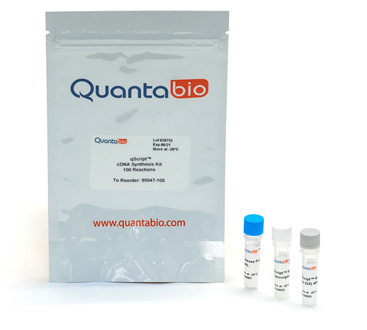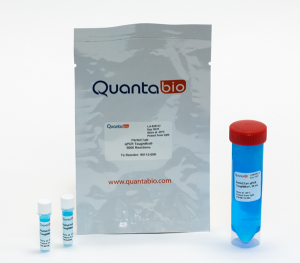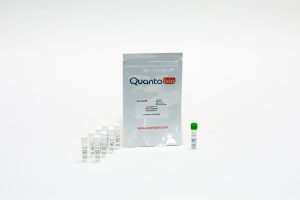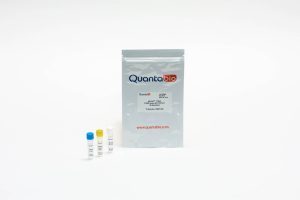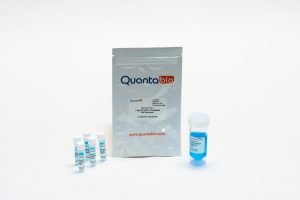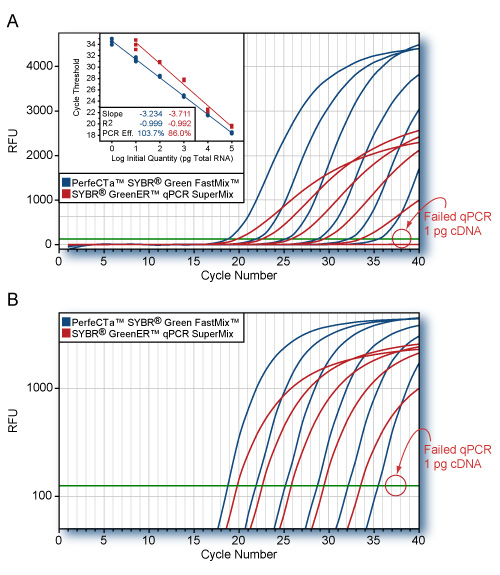qScript cDNA Synthesis Kit
| Product | Kit Size | Order Info |
|---|---|---|
| qScript cDNA Synthesis Kit | 25 x 20 μL rxns (1 x 25 µL) | Order (95047-025) |
| qScript cDNA Synthesis Kit | 100 x 20 μL rxns (1 x 100 µL) | Order (95047-100) |
| qScript cDNA Synthesis Kit | 500 x 20 μL rxns (1 x 500 µL) | Order (95047-500) |
Documents
Description
Features & Benefits
- Economical 2-component kit ideally suited for high throughput expression studies
- Optimized, double pre-primed master mix component ensures equal representation of 5′ and 3′ RNA sequences ≤ 1kb for quantitative and conventional two-step RT-PCR
- Broad linear dynamic detection range with limiting (10pg) or plentiful (1ug) samples of total RNA
Description
The qScript cDNA Synthesis Kit is a sensitive and easy-to-use solution for RNA quantification using two step RT-qPCR. The novel qScript Reaction Mix provides all the necessary components for cDNA synthesis except enzyme and RNA template. qScript reverse transcriptase is a mixture of an engineered MMLV RT and a ribonuclease inhibitor protein. This economical, highly stable stabilize, 2-component reagent system has been rigorously optimized to ensure sensitive and linear RNA detection with a wide-range of input RNA and relative abundance. Reagent performance is unaffected by repetitive freeze/thaw cycling (>20X), conferring greater ease-of-use and assay performance consistency. Oligo (dT) and random primers are pre-blended in a precise ratio to provide equal representation of 5′ and 3′-sequences for accurate gene expression quantification. The resulting cDNA product is directly compatible with all qPCR chemistries or conventional end-point RT-PCR of amplified fragments ≤1 kb in length.
For gene-specific priming (GSP) or two-step RT-PCR of RNA exceeding 1kb in total length, see our qScript® Flex cDNA Kit.
Applications
- 5X concentrated master mix containing: titered primer blend (oligo dT(20) and random hexamer), qPCR-optimized dNTP blend and flexible magnesium titration
- 20X concentrated qScript reverse transcriptase
- Nuclease-free water
Store components in a constant temperature freezer at -25°C to -15°C upon receipt. After thawing, mix thoroughly before using. For lot specific expiry date, refer to package label, Certificate of Analysis or Product Specification Form.
Thaw completely on ice then pulse vortex to mix and briefly spin-down to collect contents before opening tube. Concentrated reagents are viscous. When drawing out material, touch pipette tip to liquid interface but do not immerse.
Product Flyers
Product Manuals
Technical Notes
FAQs
Q1. What is the RNA input for the qScript cDNA Synthesis Kit?
The qScript cDNA Synthesis Kit provides for the quantitative conversion of 1µg to 10 pg total RNA to cDNA, with a reaction volume of 20 ul.
Q2. What is the smallest quantity of RNA detectable by the qScript™ cDNA Synthesis Kit?
Lower limits of detection by the qScript™ cDNA Synthesis Kit are dependent on many factors, such as primer design, target size, and the abundance of message. However, this system was able to detect GAPDH mRNA from as little as 1.0 pg of total HeLa RNA when used in conjunction with AccuStart Taq DNA Polymerase.
Q3. For first strand cDNA synthesis, is it better to use oligo(dT), random hexamers, gene specific primer (GSP) or combination of these primer?s
The choice of primer depends on your experimental goals. Oligo(dT) is recommended when using total RNA for cDNA synthesis. It is the key to full-length cDNA synthesis. Random hexamers give a series of short first-strand products spanning the entire mRNA. Use of random hexamers may be helpful if the PCR fragment is at the 5´ end of a large mRNA. To ensure full-length cDNA synthesis of large transcripts, oligo(dT) can be added along with random hexamers during first-strand synthesis. Gene specific primers (GSP) for cDNA synthesis may also be used and are required in a few applications such as 5´ RACE and qRT-PCR. For GC-rich templates, or templates rich in secondary structure, a GSP may not work as well as priming with oligo dT for first strand synthesis. If an RT-PCR is problematic, trying different options of oligo dT, random primers and/or GSP for priming first strand synthesis may find a solution. Oligo(dT)20 primer (Cat. No. 18418-020) is recommended for use with SuperScript III Reverse Transcriptase
Q4. Does the qScript™ cDNA Synthesis Kit include an RNase Inhibitor like the qScript™ cDNA SuperMix?
Both kits contain an RNase inhibitor protein. qScript™ cDNA SuperMix is provided as a single tube reaction of 5X concentrated master mix. It provides all necessary components for first-strand synthesis including: buffer, dNTPs, MgCl2, primers, RNase inhibitor protein, qScript reverse transcriptase and stabilizers (except RNA template) . In the case of the qScript™ cDNA Synthesis Kit, Rnase inhibitor is premixed with the reverse transcriptase and is provided as a concentrated enzyme.
Publications
CXCR4/CXCR7/CXCL12 axis promotes an invasive phenotype in medullary thyroid carcinoma
Thomas A. Werner, British Journal of Cancer – 2017
ABSTRACT
CXCR4/CXCR7/CXCL12 axis promotes an invasive phenotype in medullary thyroid carcinoma
Sex-specific phenotypes and metabolism-related gene expression in juvenile sticklebacks
Alberto Velando, Behavioral Ecology – 2017
ABSTRACT
To fully understand the evolution of sexual dimorphism, it is necessary to study how genetic and developmental systems function to generate sex-specific phenotype as well as sex-specific selection. Males and females show different patterns of energy storage and mitochondrial metabolism from early stages of life, and this may underlie sex-specific developmental pathway to shape both juvenile and adult phenotype. Here, we examined sex-specific relationships between juvenile morphology and behavior, and transcriptional profiles of 4 candidate genes related to mitochondrial function in the 3-spined stickleback. This study provides, for the first time to our knowledge, evidence for sex differences in melanin pigmentation and antipredator behavior as well as the expression of mitochondria-related genes in juvenile sticklebacks. Males were paler and bolder, and overexpressed genes involved in mitochondrial respiration and antioxidant enzymes compared to females. Relationships between phenotypic traits and gene expression were also sex-specific. In general, females showed stronger positive correlations between body size or pigmentation and the expression of genes involved in mitochondrial biogenesis and activity. In both sexes, more fearful individuals overexpressed those genes. Our results suggest that mitochondrial function may either facilitate or constrain sex-specific responses to selection on dimorphic phenotype, possibly generating intralocus sexual conflict on the transcriptional regulation of mito-nuclear genes during ontogeny. This study highlights that mitochondrial regulation plays an important role in the process of phenotypic differentiation between the 2 sexes from early stages of life before apparent sexual dimorphism appears.
Curcumin and o-Vanillin Exhibit Evidence of Senolytic Activity in Human IVD Cells In Vitro
Hosni Cherif, Journal of Clinical Medicine – 2019
ABSTRACT
Curcumin and o-Vanillin cleared senescent intervertebral disc (IVD) cells and reduced the senescence-associated secretory phenotype (SASP) associated with inflammation and back pain. Cells from degenerate and non-mildly-degenerate human IVD were obtained from organ donors and from patients undergoing surgery for low back pain. Gene expression of senescence and SASP markers was evaluated by RT-qPCR in isolated cells, and protein expression of senescence, proliferation, and apoptotic markers was evaluated by immunocytochemistry (ICC). The expression levels of SASP factors were evaluated by enzyme-linked immunosorbent assay (ELISA). Matrix synthesis was verified with safranin-O staining and the Dimethyl-Methylene Blue Assay for proteoglycan content. Western blotting and ICC were used to determine the molecular pathways targeted by the drugs. We found a 40% higher level of senescent cells in degenerate compared to non-mildly-degenerate discs from unrelated individuals and a 10% higher level in degenerate compared to non-mildly-degenerate discs from the same individual. Higher levels of senescence were associated with increased SASP. Both drugs cleared senescent cells, and treatment increased the number of proliferating as well as apoptotic cells in cultures from degenerate IVDs. The expression of SASP factors was decreased, and matrix synthesis increased following treatment. These effects were mediated through the Nrf2 and NFkB pathways
Ismael Jerez-Cepa, Frontiers in Physiology – 2019
ABSTRACT
Transport processes between aquaculture facilities activate the stress response in fish. To deal with these situations, the hypothalamic-pituitary-interrenal (HPI) axis releases cortisol, leading to an increase in circulating energy resources to restore homeostasis. However, if the allostatic load generated exceeds fish tolerance limits, stress-related responses will compromise health and welfare of the animals. In this context, anesthetics have arisen as potential agents aiming to reduce negative effects of stress response. Here we assessed the effects of a sedative dose of clove oil (CO) and MS-222 on hallmarks involved in HPI axis regulation and energy management after simulated transport, and further recovery, in gilthead seabream (Sparus aurata L.) juveniles. Fish were placed in a mobile setup of water tanks where transport conditions were simulated for 6 h. Sedation doses of either CO (2.5 mg L−1) or MS-222 (5 mg L−1) were added in the water tanks. A control group without anesthetics was also included in the setup. Half of the animals (n = 12 per group) were sampled immediately after transport, while remaining animals were allowed to recover for 18 h in clean water tanks and then sampled. Our results showed that the HPI axis response was modified at peripheral level, with differences depending on the anesthetic employed. Head kidney gene-expressions related to cortisol production (star and cyp11b1) matched concomitantly with increased plasma cortisol levels immediately after transport in CO-sedated fish, but these levels remained constant in MS-222-sedated fish. Differential changes in the energy management of carbohydrates, lipids and amino acids, depending on the anesthetic employed, were also observed. The use of CO stimulated amino acids catabolism, while MS-222-sedated fish tended to consume liver glycogen and mobilize triglycerides. Further studies, including alternative doses of both anestethics, as well as the assessment of time-course HPI activation and longer recovery periods, are necessary to better understand if the use of clove oil and MS-222 is beneficial for S. aurata under these circumstances.
Impaired HDL Function Amplifies Systemic Inflammation in Common Variable Immunodeficiency
Magnhild E. Macpherson, Scientific Reports – 2019
ABSTRACT
Common variable immunodeficiency (CVID) is the most common symptomatic primary immunodeficiency, characterized by inadequate antibody responses and recurrent bacterial infections. Paradoxically, a majority of CVID patients have non-infectious inflammatory and autoimmune complications, associated with systemic immune activation. Our aim was to explore if HDL, known to have anti-inflammatory properties, had impaired function in CVID patients and thereby contributed to their inflammatory phenotype. We found reduced HDL cholesterol levels in plasma of CVID patients compared to healthy controls, particularly in patients with inflammatory and autoimmune complications, correlating negatively with inflammatory markers CRP and sCD25. Reverse cholesterol transport capacity testing showed reduced serum acceptance capacity for cholesterol in CVID patients with inflammatory and autoimmune complications. They also had reduced cholesterol efflux capacity from macrophages to serum and decreased expression of ATP-binding cassette transporter ABCA1. Human HDL suppressed TLR2-induced TNF release less in blood mononuclear cells from CVID patients, associated with decreased expression of transcriptional factor ATF3. Our data suggest a link between impaired HDL function and systemic inflammation in CVID patients, particularly in those with autoimmune and inflammatory complications. This identifies HDL as a novel therapeutic target in CVID as well as other more common conditions characterized by sterile inflammation or autoimmunity.
Safety Data Sheets (SDS)
CofA (PSF)
PSF-95047-100-Lot#019343
PSF-95047-100-Lot#020927
PSF-95047-500-Lot#016357
PSF-95047-500-Lot#020874
PSF-95047-025-Lot#021826
PSF-95047-025-Lot#022998
PSF-95047-100-019572
PSF-95047-100-Lot#021944
PSF-95047-100-Lot#022050
PSF-95047-100-Lot#022340
PSF-95047-100-Lot#022341
PSF-95047-100-Lot#023101
PSF-95047-100-Lot#023102
PSF-95047-100-Lot#023384
PSF-95047-500-Lot#021997
PSF-95047-500-Lot#021998
PSF-95047-500-Lot#021998
PSF-95047-500-Lot#021999
PSF-95047-500-Lot#022241
PSF-95047-500-Lot#023103
PSF-95047-500-Lot#023104
PSF-95047-500-Lot#023105
PSF-95047-025-Lot#023619
PSF-95047-025-Lot#023620
PSF-95047-100-Lot#023958
PSF-95047-025-Lot#024727
PSF-95047-025-Lot#024728
PSF-95047-025-Lot#024729
PSF-95047-100-Lot#025243
PSF-95047-100-Lot#025242
PSF-95047-025-Lot#025732
PSF-95047-025-Lot#026641
PSF-95047-025-Lot#026642
PSF-95047-100-Lot#026644
PSF-95047-100-Lot#026645
PSF-95047-100-Lot#027546
PSF-95047-500-Lot#027547
PSF-95047-025-Lot#027999
PSF-95047-100-Lot#028000
PSF-95047-500-Lot#028001
PSF-95047-100-Lot#028755
PSF-95047-500-Lot#028756
PSF-95047-025-Lot#029016
PSF-95047-100-Lot#029017
PSF-95047-100-LOT#66139688
PSF-95047-025-LOT#66139685
PSF-95047-500-LOT#66140677
PSF-95047-025-LOT#66146770
PSF-95047-100-LOT#66151050
PSF-95047-500-LOT#66154136

